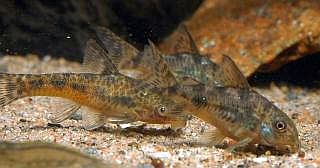Otocinclus Catfish (Otocinclus sp.) are a popular tropical species of algae eating catfish considered by many tropical fish keeping enthusiasts to be the most desired algae cleaner of all time.
All Otocinclus spp. species are super efficient algae eaters that are usually purchased by tropical fish keeping enthusiasts to help clean up undesirable algae from community tanks. They are very small, only reaching a maximum length of 2 inches, but this allows them to eat micro algae without damaging the leaves of aquarium plants. They do a far superior job than the various species of Plecostomus that most tropical fish shops sell for this purpose.
Otocinclus Catfish (Otocinclus sp.) are widely distributed east of the Andes in South America and throughout the lowlands from northern Venezuela to northern Argentina. They are generally absent from the Amazon and the Orinoco lowlands.
Like other loricariids, Otocinclus have an underslung sucker mouth with rows of amour plating covering their bodies. They are some of the smallest loricariids; the smallest being Otocinclus tapirape at only 15/16 “, with Otocinclus flexilis being the largest at 2 11/64″.
Otocinclus spp. have adaptations that allow them to breathe atmospheric air. They have a duct at the junction between the esophagus and the stomach that expands into an enlarged, ring like diverticulum, that gives them the ability to breathe air when needed and absorb oxygen from what they swallow. Prior to surfacing they release air through their mouth and gills.
Otocinclus are an active species that are usually found in small streams or along the margins of larger rivers clinging to rocks and other substrates with their sucker like mouths.
They live in shoals or large schools and feed on algae, small animals and detritus adhering to roots, stones, macrophytes, and broad leaved grasses in the mid to upper water column.
Otocinclus prefer well oxygenated, moderate to slow flowing environments, closer to the river banks where they spend most of their time near the surface of the water.
Unlike many other loricariid species where the males build a nest and guards the eggs until hatching; Otocinclus are egg scatters and lay adhesive eggs on broad leaved grasses, river rock, roots, etc. The leave their offspring to fend for themselves.
Three Otocinclus species are believed to be Batesian mimics of certain Corydora Species.
Otocinclus mimulus, Otocinclus flexilis, and Otocinclus xakriaba are considered to be Batesian mimics of C. diphyes, C. paleatus, C. nattereri, and C. garbei, respectively.
These Corydoras species have bony armor plates and strong, sometimes venomous spines that are used as a defense mechanism and that make them less palatable to other predatory fish.
It is believed that by mimicking these species in size and coloration; Otocinclus spp. avoid predation in their natural environment.
Otocinclus Catfish should be housed in a well aerated, highly filtered aquarium of at least 30 gallon capacity with good water movement. A densely planted tank with rocks and driftwood roots will provide plenty of hiding spaces to prevent the fish from being stressed. Water parameters vary slightly with species location but are generally: 74-79° F, KH 6-10, pH 6.8-7.5
All Otocinclus Catfish are social, peaceful catfish that prefer being kept in small schools of at least 6 to 8 specimens. They can be kept in community aquariums with smaller non aggressive species but should never be housed in immature aquarium setups. Under no circumstance should they ever be used to cycle a new aquarium setup.
A densely planted mature aquarium with a good growth of algae will sustain Otocinclus however, if no algae is present in the tank, they must be fed a supplement of a vegetable based flake food and sinking algae wafers.
There are currently 18 recognized species in this genus that are listed below:
Otocinclus macrospilus Eigenmann & Allen, 1942
Otocinclus huaorani Schaefer, 1997
Otocinclus hoppei Miranda-Ribeiro, 1939
Otocinclus hasemani Steindachner, 1915
Otocinclus flexilis Cope, 1894 (peppered oto)
Otocinclus cocama Reis, 2004 (zebra oto)
Otocinclus caxarari Schaefer, 1997
Otocinclus bororo Schaefer, 1997
Otocinclus batmani Lehmann A., 2006
Otocinclus arnoldi Regan, 1909
Otocinclus mangaba Lehmann A., Mayer & Reis, 2010
Otocinclus mariae Fowler, 1940
Otocinclus mimulus Axenrot & Kullander, 2003
Otocinclus mura Schaefer, 1997
Otocinclus tapirape Britto & Moreira, 2002
Otocinclus vestitus Cope, 1872
Otocinclus vittatus Regan, 1904
Otocinclus xakriaba Schaefer, 1997
Of all the above, there are only two commonly imported species of Otocinclus catfish; Otocinclus vestitus and Otocinclus mariae.
Frequently other rare and uncommon varieties are mixed together with O. vestitus and O. mariae in shipments made to wholesalers. All are excellent algae removers.


